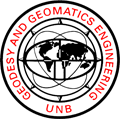
UNB GEOIDE NCE Projects
- Problem statement:
- The understanding of earthquakes and the assessment of their hazard requires the monitoring and modeling of crustal strain. Existing continuous GPS networks and high precision geodetic measurements need to be enhanced to be used operationally.
- Objectives:
- To develop GPS and high precision geodetic measurements for Natural Hazards and Disaster Monitoring.
- Leaders:
- J. Merriam (U. of Saskatchewan) and W. Cannon (York U.)
- Team:
- R. Langley, P. Vaníček (U. of New Brunswick)
G. Spence (U. of Victoria)
M. van der Kooij (Atlantis Scientific Inc.)
- Problem statement:
- 3D GPS positioning of the survey vessel would make bathymetric survey operations more cost effective.
- Objectives:
- To improve the phase ambiguity resolution methods and algorithms for kinematic GPS positioning over long distances.
- Leaders:
- R. Santerre (U. Laval) and R. Langley (U. of New Brunswick)
- Problem statement:
- Atmospheric and weather conditions induce errors in remote sensing data. The research is particularly concerned with radar remote sensing.
- Objectives:
- To determine the weather effects on radar signals. To develop methods for the retrieval of atmospheric parameters from weather radar and satellite data.
- Leaders:
- I. Rubinstein (CRESTech) and M. Collins (U. of New Brunswick)
- Team:
- M. Sideris (U. of Calgary)
J. Buckley (Royal Military College)
H. Whiteley (U. of Guelph)
- Problem statement:
- The gravity field of the Earth provides fundamental information for geophysical exploration and mapping. The resolution of this global height reference is especially poor for wavelengths between 10 km and 500 km. Satellite methods over land areas do not resolve this part of the spectrum and ground gravity in most areas is not sufficient to complement satellite data.
- Objectives:
- To exploit gravimetry and geoid measurements for geology and mapping.
- Leader:
- K.-P. Schwarz (U. of Calgary)
- Team:
- M. Sideris (U. of Calgary)
R. Langley (U. of New Brunswick)
K. Tennant (Intermap Techn.)
S. Pagiatakis (NRCan, GSD)
- Problem statement:
- Comprehensive decision support tools that integrate data and stakeholder priorities are virtually non-existent in watershed and coastal zone management strategies.
- Objectives:
- To enhance decision processes related to watershed and coastal zone management.
- Leader:
- B. St-Onge (Université du Québec à Montréal)
- Team:
- D. Coleman (U. of New Brunswick)
R. Hausler, J.-P. Waaub (UQAM)
P. Keller (U. of Victoria)
R. Loulou (McGill U.)
Y. Malczewski, D. Shrubsole (U. of Western Ontario)
- Problem statement:
- The problem of georeferencing is the basis for real time mapping functionality. This project is concerned with real time mapping for the generation of geospatial data.
- Objectives:
- To develop systems that integrate data streams of multisensor and multisource data for real-time applications.
- Leader:
- M. Chapman (U. of Calgary)
- Team:
- M. Boulianne (U. Laval)
K. Schwarz (U. of Calgary)
M.A. Collins (U. of New Brunswick)
D. King (Carleton U.)
- Problem Statement:
- The geoid is the equipotential surface of the Earth's gravity field that best approximates the mean sea level. Such a reference surface is needed for modern mapping in oceanography and geophysics.
- Objectives:
- The overall objective is to obtain a precise geoid determination for geo-referencing and oceanography.
- Leader:
- M.G. Sideris (U. of Calgary)
- Team:
- K.R. Thompson (Dalhousie U.)
P. Vaníček (U. of New Brunswick)
R. Hendry (Fisheries and Oceans - BIO)
C. O'Reilly (Fisheries and Oceans - CHS)
S. Pagiatakis (NRCan - GSD)
- Problem Statement:
- A very large amount of spatial data is stored in disparate and partially redundant GIS and DBMS. The usefulness of these data to support decision-making is limited. These limitations stem from several sources including the lack of coherent spatial data infrastructures, adaptations of data warehouse technology and poor tools for spatial data query.
- Objectives:
- To design the specifications for a coherent suite of web- oriented tools for geospatial decision making.
- Leader:
- Y. Bédard (U.Laval)
- Team:
- D. Coleman, B. Nickerson (U. of New Brunswick)
J. Han (Simon Fraser U.)
T. Merrett (McGill U.)
B. Moulin (U. Laval)
C.T. Tao (U. of Calgary)


